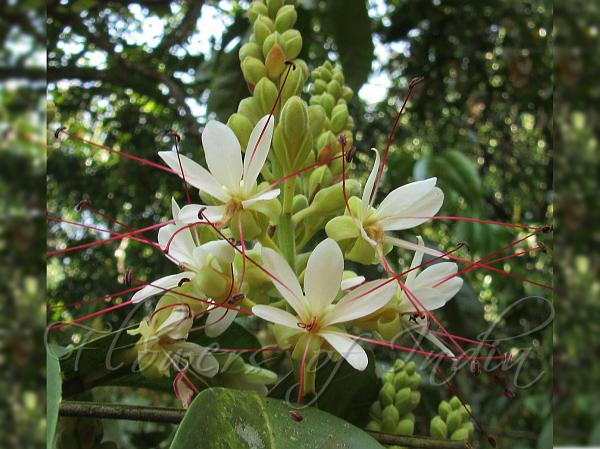|
| Malabar Humboldtia |
|

|

|
|
|
|
Photo: |
Botanical name: Humboldtia vahliana Family: Caesalpiniaceae (Gulmohar family)
Malabar Humboldtia is a tree, up to 18 m tall, bark
5-6 mm thick, dark brown mottled with white; blaze pink; internodes of
the branchlets solid, round, hairless; branchlets sometimes zig-zag.
Leaves are paripinnate, alternate; stipules 1.5-3 x 2.2 cm, lateral,
persistent, ovate-heart-shaped. Leaflet-stalk is 7-10 mm long, stout,
velvet-hairy or not; blade 10-25 x 3-6.4 cm, oblong-lanceshaped, base
blunt, tip tapering, leathery, hairless; lateral nerves 8-14 pairs.
Flowers are bisexual, white, 27-30 mm long, in many flowered, in
leaf-axils brown velvety racemes; flower-stalk 5-6 mm long; bracts
lanceshaped, pointed, hairy on both surfaces, persistent; bracteoles 2,
fused by base, obovate, rounded at tip, fugacious; calyx tube 8-10 mm
long, lined by the disc, obconical, brown hairy; lobes 4,
obovate-oblong, rounded at tip, slightly concave; petals 5, 10-12 x 4
mm, obovate, shortly clawed, broadly rounded at tip, hairless; stamens
are 5, perfect, alternating with 5 minute staminodes; filaments 1 cm
long, red; ovary 4-5 mm long, half inferior, obliquely linear, ovules
3-4; style 10-15 mm long, thread-like, hairy at base, reddish; stigma
capitate. Fruit is a pod, 15-20 x 3.7-6 cm, elliptic, compressed,
sutures thick valves prominently veined, brown hairy; seeds 3-4, almost
round, hairless. Malabar Humboldtia is endemic to the Western Ghats -
occasional in South Sahyadri and in South Malabar; rare in
Palakkad-Kozhikode Region of North Malabar. Flowering: February-April.
Medicinal uses: Bark of the tree is used in
biliousness, leprosy, ulcers and epilepsy.
Bark of the tree is used in
biliousness, leprosy, ulcers and epilepsy.
Medicinal uses:
 Bark of the tree is used in
biliousness, leprosy, ulcers and epilepsy.
Bark of the tree is used in
biliousness, leprosy, ulcers and epilepsy. | Identification credit: Ajayan Sadanandan | Photographed in Kothamangalam, Ernakulam, Kerala. |
• Is this flower misidentified? If yes,